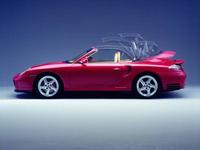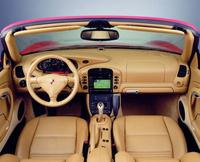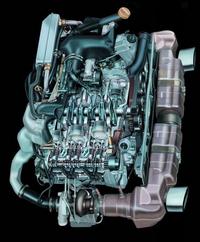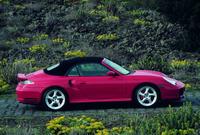Porsche Introduces First 911 Turbo Cabriolet In 14 Years
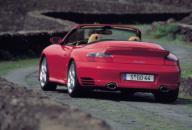 |
ATLANTA, July 22 -- Porsche has announced it will produce the first 911 Turbo Cabriolet since 1989. Arriving at Porsche dealerships in the fall of this year, the 2004 Porsche 911 Turbo Cabriolet is based on the existing Porsche 911 Turbo Coupe, incorporating the Coupe's engine, body structure, four-wheel drive system, chassis, and suspension and brake systems.
Power for the new 911 Turbo Cabriolet, transferred through either the manual six-speed or optional five-speed Tiptronic automatic transmission, comes from a twin-turbocharged 3.6-liter six-cylinder engine producing 415 (SAE) horsepower. It propels the car from 0 to 62 mph (100 km/h) in just 4.3 seconds and to a top track speed of 189 mph (305 km/h).
Taking styling features from the 911 Turbo Coupe, the Cabriolet incorporates the Coupe's three large front air intake cooling scoops, intercooler air intakes in the rear side panels, and a rear spoiler that deploys at 75 mph (120 km/h) and retracts at 55 mph (80 km/h). As found on all current Porsche 911 Cabriolets, the Turbo Cabriolet is equipped with a power convertible top that raises or lowers in just 20 seconds. To maintain body stiffness, the 911 Turbo Cabriolet's structure is enhanced with reinforced side-sills featuring body panels and elements doubled in thickness, additional junction plates, and shaft reinforcements behind the B pillar.
Like the Turbo Coupe and all Porsche Carrera(R) 4 models, the Turbo Cabriolet's four-wheel drive system delivers from five to 40 percent of the engine power to the front wheels depending on driving conditions. The new Turbo Cabriolet is also fitted with the Porsche Stability Management (PSM) system as standard equipment.
To ensure supreme stopping power at all times without the slightest fading, the new Turbo Cabriolet comes with four-piston fixed-caliper brakes plus inner-vented, cross-drilled brake discs front and rear measuring 13.0 in. (330 millimeters) in diameter. Porsche Ceramic Composite Brakes (PCCB) are available as an option, setting new standards in terms of brake response, fade-free performance, low weight and a long service life. Eighteen-inch light alloy wheels with tires measuring 225/40 on the front axle and 295/30 on the rear axle transfer the braking power to the road.
The 911 Turbo Cabriolet comes with an extensive range of standard equipment. This includes metallic paint, full leather interior, a hardtop and wind deflector, Bose audio system and Porsche Communication Management (PCM) system comprising a double tuner, CD player, navigation system and trip computer. It will be available beginning in October of this year starting at a Manufacturers Suggested Retail Price of $128,200 U.S. and $187,800 Canadian.
Porsche Cars North America, Inc. (PCNA), based in Atlanta, Ga., and its subsidiary, Porsche Cars Canada, Ltd., are the exclusive importers of Porsche vehicles for the United States and Canada. A wholly owned, indirect subsidiary of Dr. Ing. h.c.F. Porsche AG, PCNA employs approximately 200 people who provide Porsche vehicles, parts, marketing and training for its 204 U.S. and Canadian dealers. They, in turn, provide Porsche owners with best- in-class service.
The new Porsche 911 Turbo Cabriolet: fresh air and muscle all in one
Porsche AG has issued the following press release:
Enjoying the thrill of open-air motoring in combination with supreme power and performance – this is the unique experience offered by the new top-of-the-range 911 Turbo Cabriolet with Porsche's famous turbocharged power unit at the rear providing outstanding performance wherever you go. Maximum output of this horizontally-opposed six-cylinder boosted by two turbochargers is 309 kW or 420 bhp at 6000 rpm. And maximum torque of 560 Newtonmetres or 413 lb-ft is maintained consistently from 2700 – 4600 rpm.
Not only the wide wheel arches extended 60 millimetres or 2.36" further out than on the 911 Carrera Cabriolet give this very special Turbo model its characteristic looks and design, but also the intake openings for the intercooling system on the rear side panels. Further features typical of this model are the charge air outlets on the lower side section of the rear body panel. Yet another characteristic feature is the retracting rear wing serving to reduce lift forces on the rear axle. In conjunction with the striking lip on the front spoiler, this ensures the necessary aerodynamic balance required on an outstanding sports car of this calibre with its supreme driving dynamics. From the front the car's “thirst" for fresh air is obvious at first sight: Three large openings guide the flow of cooling air to the three radiators in front of the wheels and in the middle of the car. Two further openings in the front spoiler lip, in turn, ensure an efficient flow of fresh air to the high-performance brakes.
VarioCam Plus optimising valve timing and lift Intake-side camshaft management on the turbocharged engine of the Porsche 911 is combined with valve lift control also operating on the intake side. With this system appropriately bearing the name VarioCam Plus, valve lift is masterminded by two interacting, switching cup tappets operated by two cams of different size on the camshaft. This not only optimises engine power and torque, but also reduces fuel consumption and exhaust emissions whilst improving motoring refinement at the same time.
Turbocharging for maximum power Two turbochargers switched in parallel are crucial to the supreme power and performance offered by this outstanding six-cylinder. Drawing in air through a single-unit air filter housing, the turbochargers first compress the flow of air and then guide the ongoing stream through an intercooler in each of the wheel houses behind the rear wheels, after which the air flow comes together again in front of the throttle butterfly operated electrically. As a result the performance offered by the new top-of-the-range Cabriolet in the 911 model series is virtually identical to that of the Turbo Coupé: with its six-speed manual gearbox featured as standard the open-air Turbo accelerates in 4.3 seconds from 0-100 km/h (Coupé: 4.2 seconds). It then reaches 160 km/h or 99 mph in 9.5 seconds (Coupe: 9.3 seconds) and rockets on to its top speed, with the roof closed, of 305 km/h or 189 mph, which is exactly as fast as the Coupé. Acceleration from 80-120 km/h in fifth gear, in turn, comes in exactly five seconds.
Four-wheel drive and PSM for outstanding driving characteristics Like the Coupé, the new 911 Turbo Cabriolet comes as standard with four-wheel drive: Depending on driving conditions, the front wheels running on 225/40 R 18 tyres convey up to 40 per cent of the engine's drive power to the road. The focus, however, is not so much on traction alone, but rather on supreme driving characteristics and safety even in an extreme situation. Active driving safety of the highest calibre is also ensured by PSM Porsche Stability Management fitted as standard: incorporating the most sophisticated sensors, the system “sees" whether the car is following the path determined by the driver.
Brakes like in motorsport – and available with ceramic discs as an option The 911 Turbo Cabriolet naturally boasts Porsche's proven brake system with monobloc fixed callipers all round: Four-piston fixed callipers interacting with cross-drilled and inner-vented brake discs ensure superior stopping power both front and rear. As an option the new Cabriolet is available with ceramic brake discs, Porsche Ceramic Composite Brakes (PCCB) being a combination of composite ceramic discs and six-piston fixed callipers on the front wheels and four-piston callipers at the rear.
Stiff body with rollbars moving up automatically whenever required The bodyshell of the Porsche 911 Turbo Cabriolet is based on the body structure of the Coupé. The main differences are specific reinforcements and strengthening body elements wherever required, serving to replace the stabilising effect of the fixed roof. To increase body stiffness, the body-in-white of the Cabriolet comes with reinforced side-sills featuring body panels and elements doubled in thickness, additional junction plates and so-called shaft reinforcements behind the B-pillar. Indeed, this is the first Porsche sports car to use ultra-strong DP600 steel at this point in the interest of maximum strength and stiffness. A further feature is that the shaft reinforcements are not only welded, but also bonded, this combination of joining technologies and the additional reinforcement provided by the bond serving to take up energy even more consistently in a collision. Like on all Porsche 911 Cabriolets, two rollbars featured as standard efficiently protect the car's occupants in a rollover. Hidden discreetly behind the rear seats, the rollbars move up within split-seconds under spring pressure as soon as a sway sensor determines that the car might roll over.
Roof opening and closing even while driving The 911 Turbo Cabriolet comes with a fully-retracting roof moving down beneath the roof compartment lid whenever opened. The entire process of opening or closing the roof is masterminded electrohydraulically within just 20 seconds. And the driver is able to operate the roof not only with the car at a standstill, but also while driving at a speed of up to 50 km/h or 31 mph. Even under these conditions, the entire process of opening the roof does not take one second longer, only the process of closing the roof requiring about six seconds more due to greater air resistance. A wind deflector and a hardtop both come as standard on the 911 Turbo Cabriolet.
Standard equipment of the highest calibre The new 911 Turbo Cabriolet comes with a wide range of sophisticated features. Just some examples are metallic paintwork, leather upholstery, automatic air conditioning, electrically operated seats complete with a memory function, a BOSE sound system, heat-insulating glass with a green stripe in the windscreen, interior and exterior rear-view mirrors with an automatic anti-dazzle function, a rain sensor, bi-xenon headlights, central locking, and an alarm system with interior surveillance.
Continuing a legend Introducing this new top-of-the-range model, Porsche is once again placing a 911 Turbo Cabriolet right at the top of the family after a break of 14 years: From 1987 – 1989 the Porsche 930, as the first Turbo was code-named within the Company, set the first milestone in the history of these outstanding open-air sports cars. With cylinders still featuring two valves each at the time, the 3.3-litre power unit driving the first Turbo Cabriolet offered maximum output quite unique at the time of 300 bhp or 221 kW. Acceleration from 0 – 100 km/h was in 5.2 seconds and the car had a top speed of 260 km/h or 161 mph.
2003-07-22 Please quote Autoindex.org if You use this news article!



